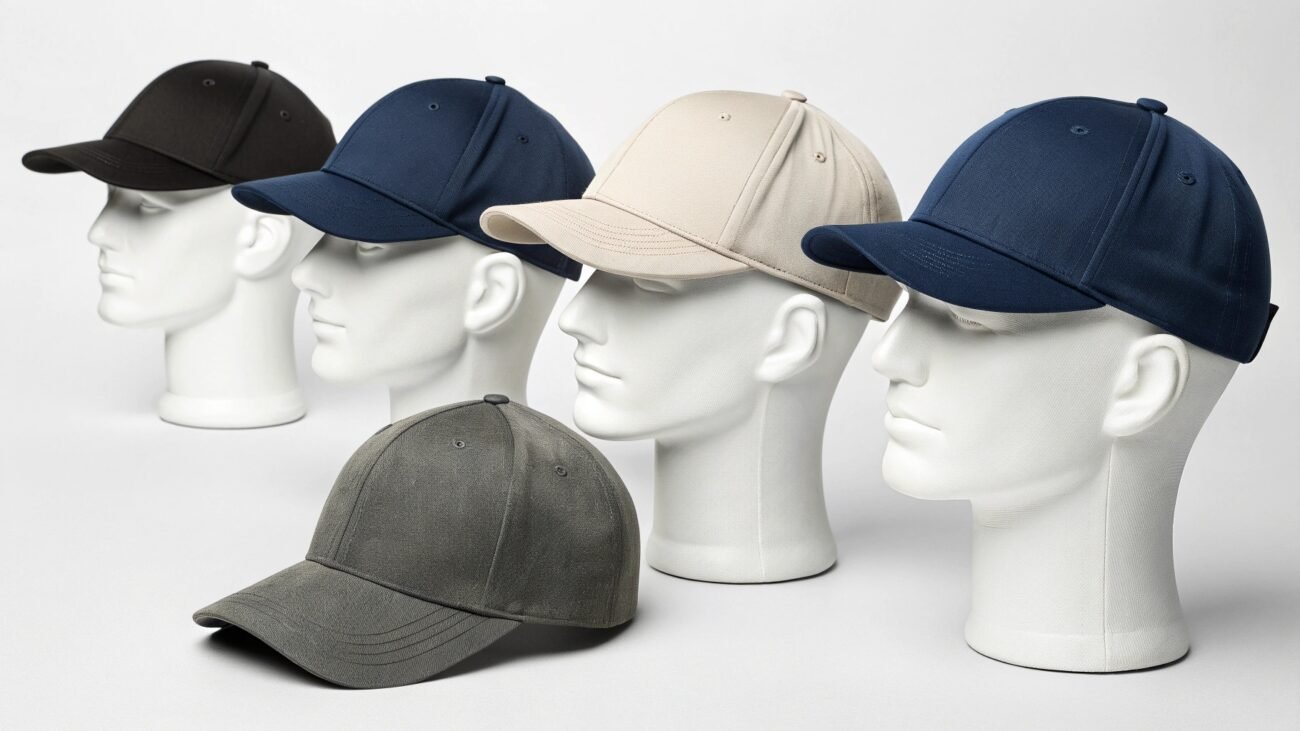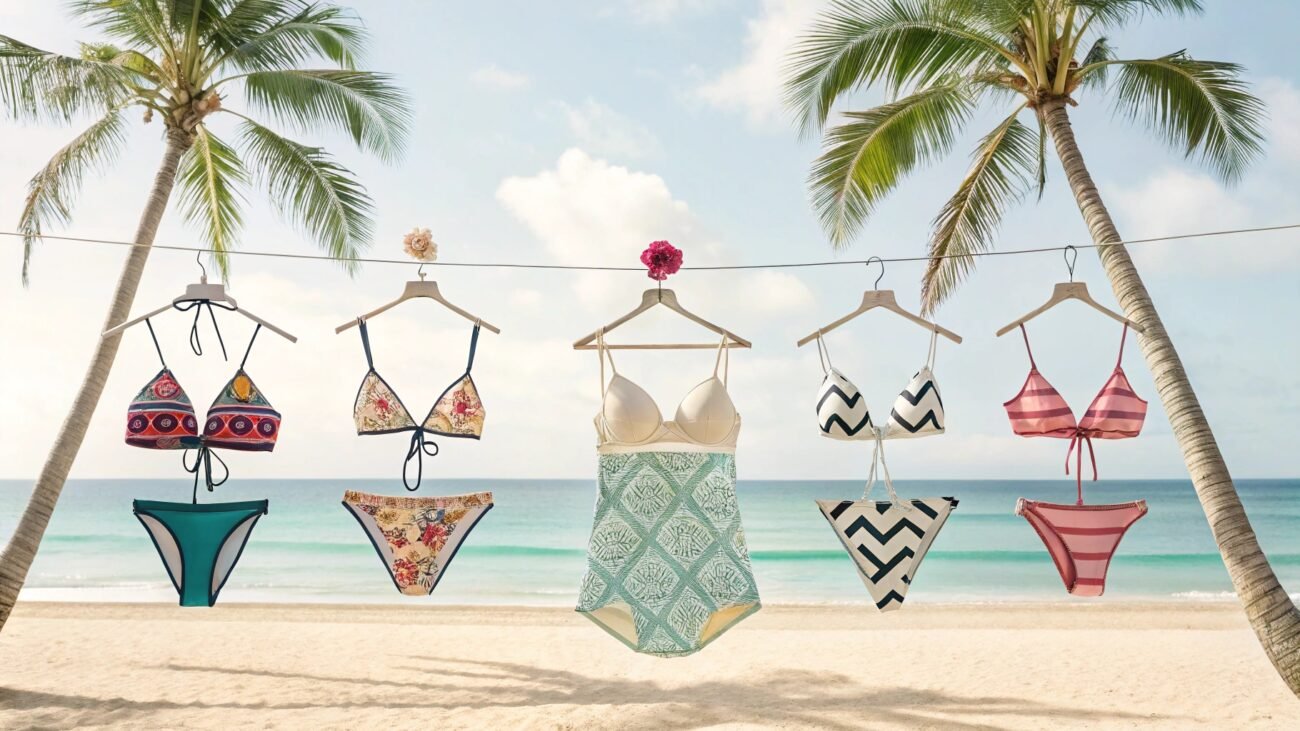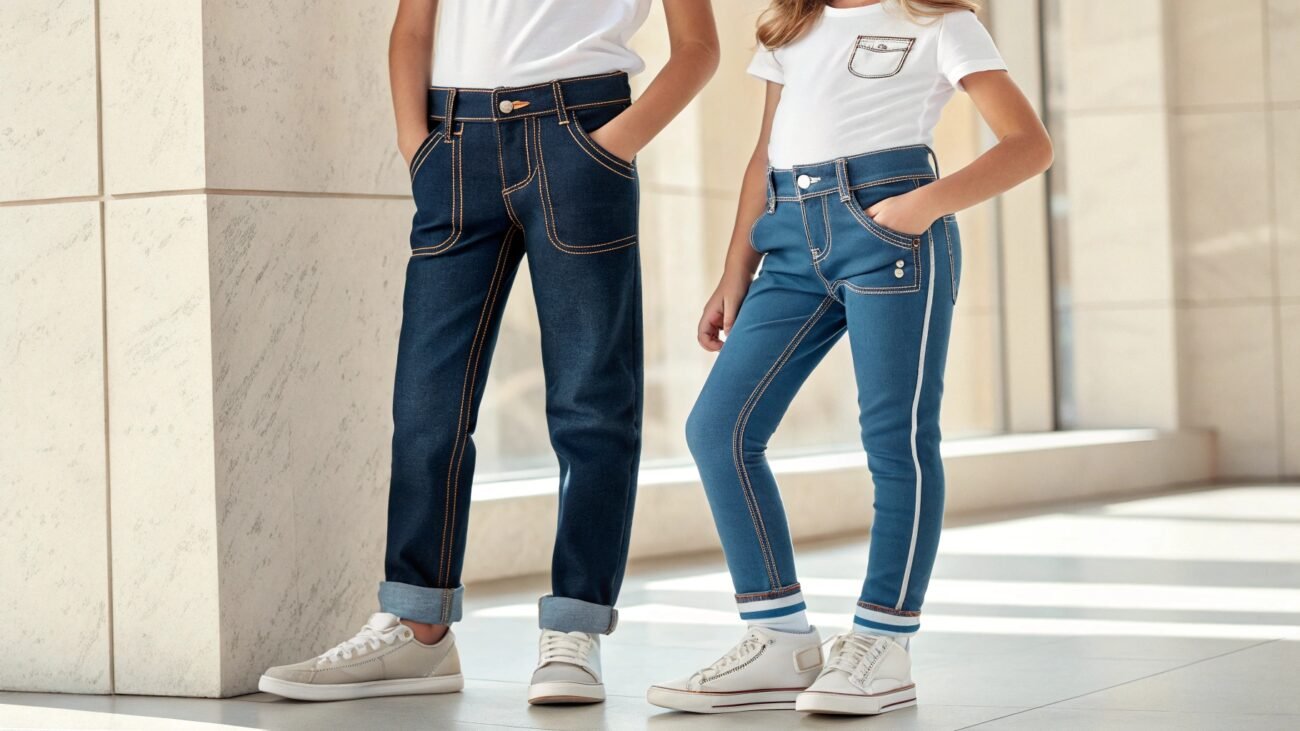Have you ever noticed how jeans sometimes feel different to wear? Do they have all-together different wearing experiences? It is all because of the different types of denim fabric available in the market; long gone are those days when denim was just about making pants with traditional twill cotton.
Table of Contents
ToggleThese days, designers with manufacturer collaboration have been able to design most, if not all, garment types with jeans. In the market, there are also denim-made accessories and decorative items.
Benefits from reading this blog?
- Understanding what constitutes denim fabric
- Multiple Types of Denim Availability
- Guide in helping to pick the right denim for your wardrobe
So, without wasting more time, let’s take a deep dive into Jean’s world.
Introduction: What Is Denim?
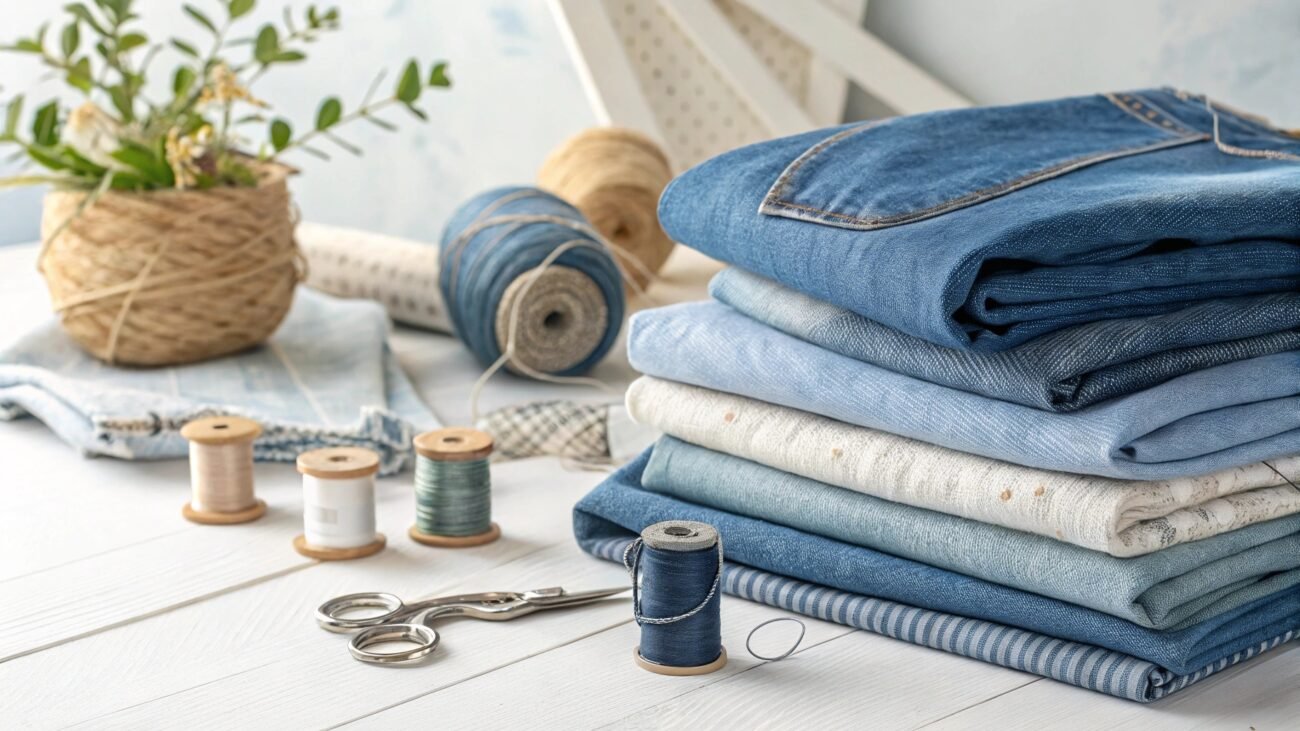
Denim is perhaps the most iconic fabric out there in the world, and it wouldn’t be right to not mention the main reason for denim’s popularity being, “Jeans Pants.” Over the years in America, jeans have been proven to be extremely reliable and long-lasting, so much so that it has become the longest-trend reigning garments in the history of America.
But the question is, “What makes denim so special?“.
Well, denim is a strong cotton fabric made via the process of twill weave, and it is thanks to that process that denim-made clothes are known for resiliency, adaptability and easy fashion allure. You may have seen it being indigo or blue colour, but thanks to the rise of the fashion industry, there are other types of denim colours available, such as:
- Black
- Pink
- Grey green
- Shades of brown
How is Denim Produced?
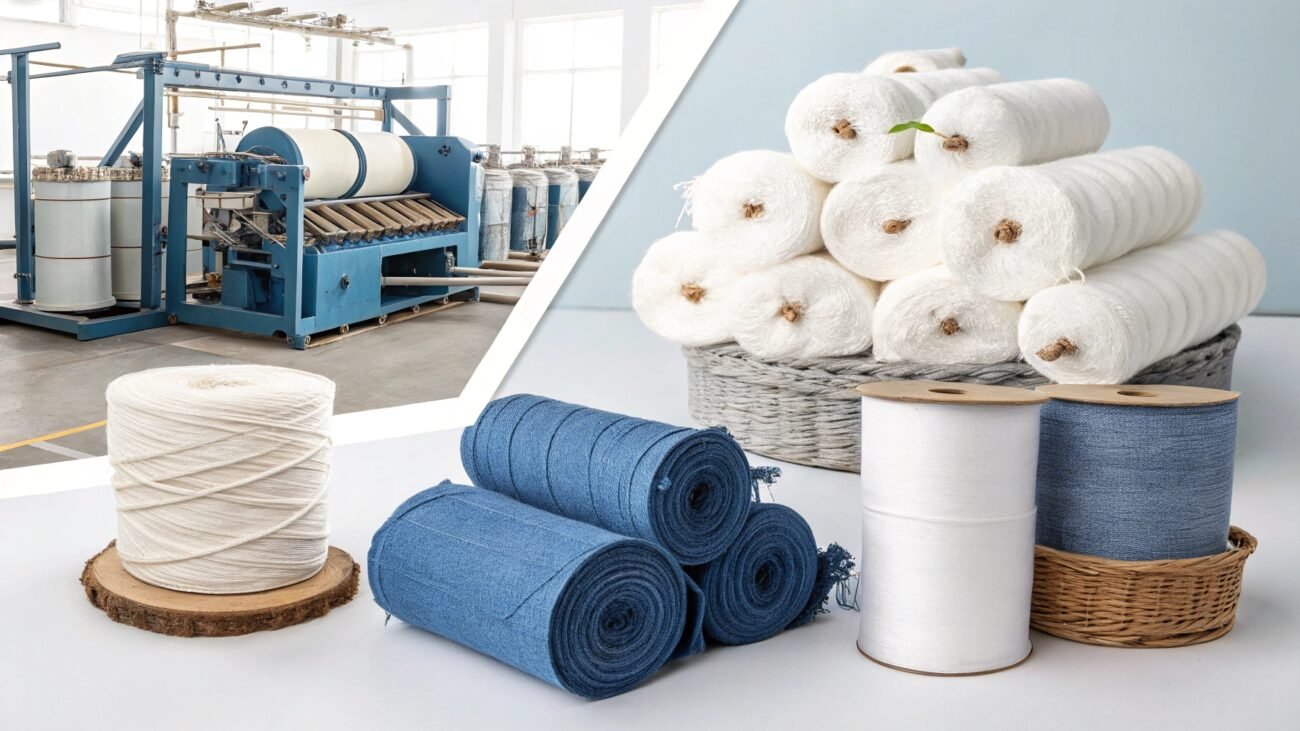
If I say you can make your own denim fabric, would you believe me?. Well, you have to, considering the fact that denim is really easy to make with the right equipment and colouring it perhaps is even easier.
Here’s a detailed outlook on denim production:
Cotton Cultivation:
Denim production begins after the cultivation of good quality cotton. In response to gradual growth, it develops a thick ball of fibre around its seeds, and later, these fibre-coated seeds are collected and then separated either through manual labour or by using sophisticated machines.
Yarn Processing:
Afterwards, cotton fibres are combed into long strings, which are later spun into yarn using a rotor spinning machine. However, this is the stage that contributes to differential denim types as throughout the yarn processing, a variety of washes, dyeing techniques and treatments are applied depending on the requirements.
Final Production Stage:
Once the yarn has been formed, it is then woven into the warp-face style of denim, and now it is ready to be purchased to make premium jeans.
See, formulating denim is not that difficult. Owing to such easy production, denim is not budget-breakingly expensive and is readily available in the market.
Why Should You Start a Denim Clothing Line?
The denim garments industry is growing rapidly, and now the experts over at Grand View Research are forecasting it to reach up to USD 116 billion with a growth rate of 5.9%. If this doesn’t tell you about the vastness of business opportunities in this industry, then quite frankly, I don’t know what will!
Denim Fabric Types in 2025
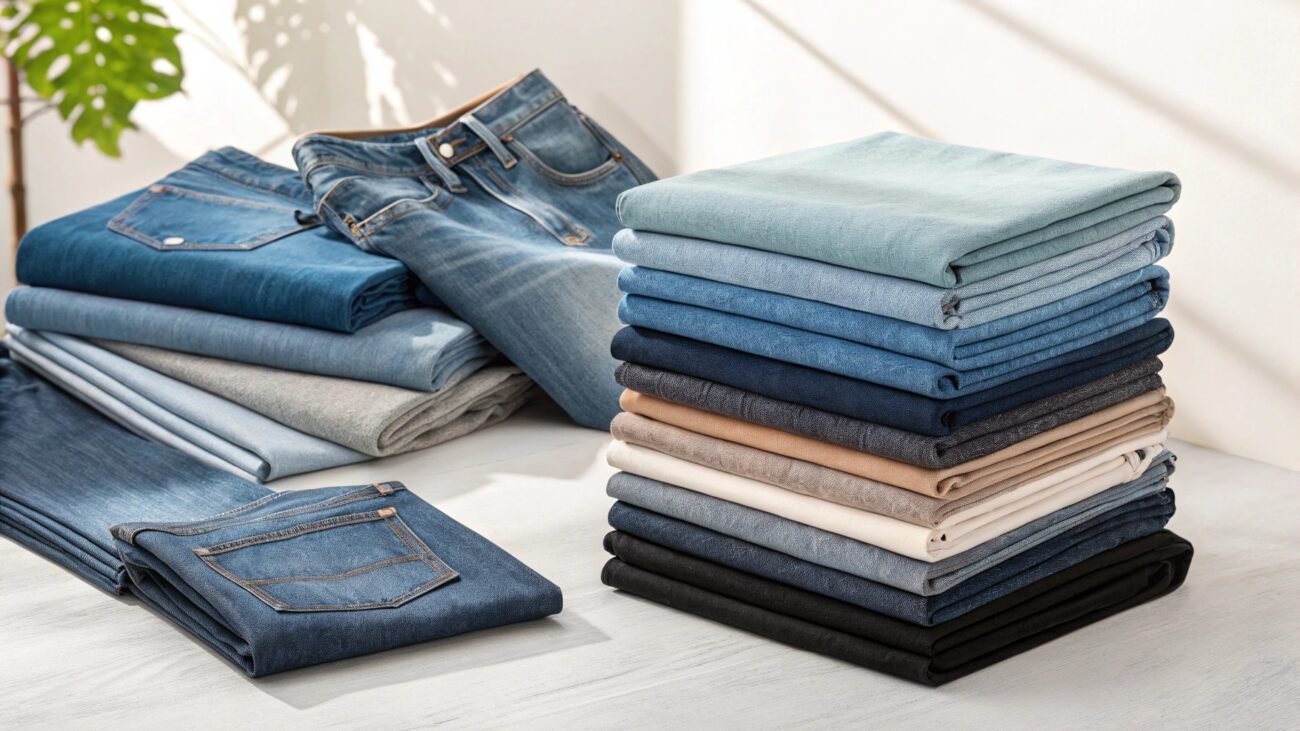
As mentioned beforehand, there are different kinds of denim, and each is best suited for a particular garment style. Suppose you want to make baggy jean pants, then selecting raw denim (“which is rather stiff and made to fit”) would be a very foolish choice. Similarly, other types of denim confer different wearing experience and feel.
I highly recommend you go over the different styles of jeans fabric mentioned below, as understanding these would allow you to level up your fashion game.
Raw Denim:
When standard denim fabric is not washed or treated with any coatings, it is then referred to as raw denim. It acquires the desired fitting once it has been worn for a year at least. Many people absolutely love them for their ruggedness and pronounced fading, which indicates a deep story behind them.
Garments made with this iteration are:
- Pants
- Jackets
- Skirts
Drawback: Unlike other denim fabrics, it is prone to shrinking after a few washes due to it being untreated.
Sanforized Denim:
Sanforization is a process to eliminate shrinkage when washed by consumers, and it is achieved by pre-shrinking of fabric during the manufacturing stage.
Sanforized denim or jeans are the type of fabric that has gone through this washing process and offers higher softness than other denim, but they fall short in being durable enough for a longer period of time. However, despite this strange balance of serviceability, most denim types of jeans are sanforized.
Stretchy Denim:
Stretch denim forms when cotton twill is interweaved with spandex or lycra; this blend results in a fabric which is a tad bit more flexible than traditional versions of denim. It is mostly used to make high-quality skinny jeans that are great for adaptable fashion.
Crushed Denim:
A very unique kind of denim which goes through multiple special treatments to create a crinkled appearance. It gives clothes a distressed yet live-in aesthetic, making them extremely popular for jackets and casual wear.
The wrinkled texture of crushed denim is brought on by these treatments:
- Pressing
- Twisting
- Squeezing
Selvedge Denim:
Selvedge denim is a premium fabric option for those who rejoice in classic artisanal appearance. This type is created on traditional narrow shuttle looms for clean and self-finished edges. Being a higher quality, it automatically translates to higher durability, unique texture and a more personalized fade over time.
Why Is Selvedge Denim Expensive?
There are multiple factors that add up to its final price. However, the main reason is the need for skilled labour as traditional methods are the only methods to make selvedge fabric.
Acid Wash Denim:
Have you ever seen jeans that look as if they had gone through grindstone? Well, such garments are made of cotton twill denim, which is aggressively treated with acids to create that “washed-up effect.”
Poly Denim:
Poly denim material is often used for casual jeans, jackets and skirts due to its enhanced durability and wrinkle resistance. However, if polyester is not blended correctly with cotton twill, then there are high chances of reduced breathability, which is unwanted in hot weather.
Noteworthy Detail: Poly denim is best for printed designs and colour dyeing due to the use of polyester, which is excellent in colour retention.
Stone-Washed Denim:
Stone-washed denim is mechanically abraded with pumice stones in large industrial washing machines. This process creates a subtle faded and worn-in look which otherwise would take years to achieve. Albeitly, stone washing severely weakens the cotton fibres, potentially shortening its lifespan as well.
Ramie Denim:
Ramie fibres are naturally obtained from the ramie plant, and when strategically incorporated into denim cotton twill, it aims to enhance not just strength and resilience but also add silky appearance and good breathability. Garments made with ramie denim are most suited for those who want comfortable jeans but with extra longevity.
Why Is Ramie Denim Not Widely Used?
Although great in its uses, ramie denim has become unviable due to its higher costs and availability issues in the market.
Chambre Fabric:
Unlike denim fabrics, chambre is a plain woven cotton that resembles the appearance of denim but is a distinctly different fabric altogether. Chambre fabric is made with a half-and-half combination of blue and white yarn, giving it a frosted appearance.
Although it looks like denim, when structural integrity is concerned, it fails to match up. However, it is still a great option for shirts and blouses where lightweightness, breathability and flowy drape are required.
| Feature | Denim Fabric | Chambray Fabric |
|---|---|---|
| Ribbing Pattern | Diagonal ribbing | Criss-cross ribbing |
| Weight & Texture | Heavier & rigid | Lighter & softer |
| Durability | Highly durable | Less durable |
| Breathability | Less breathable | More breathable |
| Best Used For | Pants, jackets & workwear | Shirts, dresses & blouses |
| Wrinkle Resistance | Less prone to wrinkling | More prone to wrinkling |
5 Tips to Pick Best Jeans
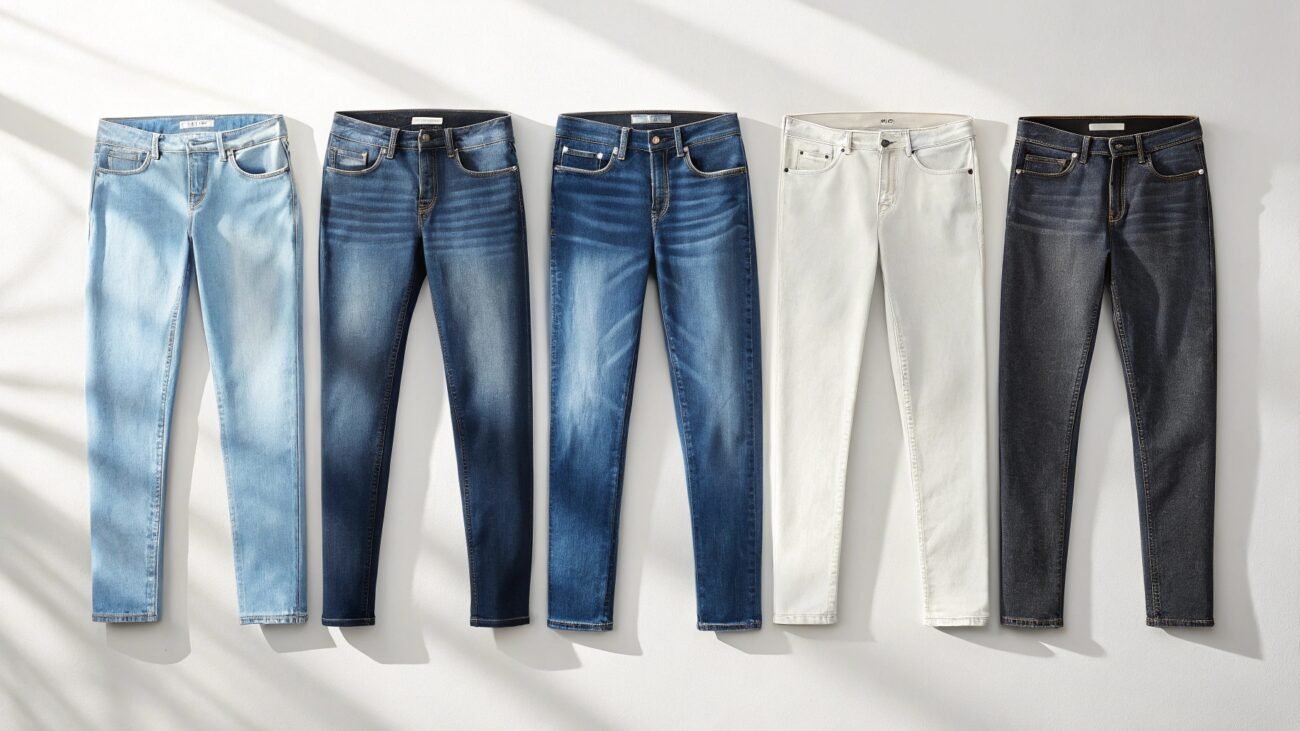
The word “Jeans” is an umbrella term and encompasses not just fabric material but pants, jackets and shirts. You may have heard plenty of times, “I got these jeans for very cheap,” or “These jeans are really good quality. Well, technically speaking, Jean is the name of the fabric, but with the interluding of human nuances, it no longer remains just that.
Having said that, there are multiple guidelines and regulations you should be very aware of when selecting jeans either for your business or for yourself.
For Businesses
Analyze Demographics:
Different people prioritize different qualities; for example, a worker would need durable and abrasion resistance before any kind of fashion aesthetic. So try to connect the dots between your brand’s core value and your potential client base before selecting any jean fabric.
Focus on Denim Blends:
Although 100% cotton is often best for jeans, consider various blends such as poly-denim and stretchable denim (“made from cotton and lycra blend”) due to their affordable cost factors. However, don’t worry; these blends are highly popular and widely used to make high-quality denim jackets & accessories along with pants.
Assess Gsm for the Most Plausible Use Case:
Gsm indicates fabric’s weight and tells you how great, or worse, a fabric’s draping, durability and suitability for different seasons is.
- Lighter GSM (8-10 oz), Good for summer & soft garments
- Heavier GSM (12-14+ oz), Great for classic & long-lasting jeans.
Evaluate Weave Type & Finishes:
Even though the twill weave is standard, consider its variations, such as left-hand twill for a softer feel or right-hand twill for more structured integrity. Also, decide if you need washed and pretreated denim for your clothes or unwashed raw denim.
Prioritizes Availability and Sustainability:
Try to design clothes which can be manufactured using widely available denim; this will ensure longer business tenures. However, if you want specific or sustainable material, then try to visit expos and digital platforms like Alibaba to find certified manufacturers with transparent supply chains.
Related Blog: Clothing Manufacturers For Startups: From Development to Production
For Regular buyers
Consider Your Lifestyle:
If you need durable jeans for high activity levels, then opt for heavier denim, but for comfortability and flexibility, look for jeans made with stretchable denim.
Fabric Content:
Always look at the labels. 100% cotton denim offers a classic feel and unique fading pattern, whereas denim blends conform to properties like stretch, softness and wrinkle resistance. Pick what resonates most with you.
Assess the Weight:
While not always mentioned on tags, you can feel the denim to roughly estimate its weight. On one side, thicker denim means high durability and warmth, whereas lighter denims are better for warmer climates where air flow is needed.
Quality Analysis:
Even with the utilization of greater and more expensive materials, always check for poor stitching or low-quality zippers that can ruin your jeans. Also, check if the seams are equally even and if the fabric is consistent or not.
Understand Denim Washings and Finishing’s:
A raw/unwashed pair of jeans will be stiff but will gradually develop personalized fitting and fade. On the other side, a washed jean will come already prepared with high softness and even artificial fades. So, choose carefully whether you want immediate comfort or personalized ageing.
Different Styles of Jeans for Body Types
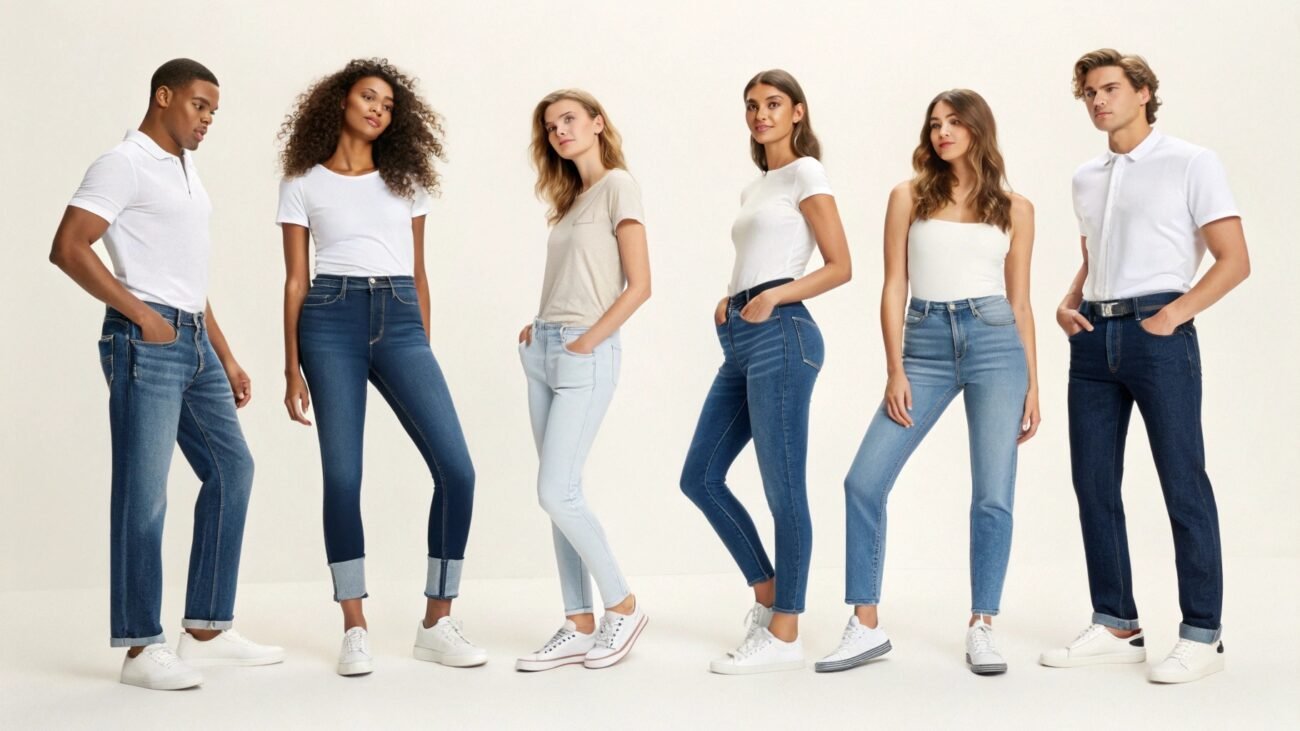
Body shape shouldn’t be the deciding factor when you are about to buy jeans, either for yourself or for your friends. Instead, you should always wear what you feel like wearing and focus on what makes you feel heard and special.
However, going by shape, selecting the right pair of jeans becomes quite easy. Here are some of the best jeans for body types:
| Body Types | Jeans Style | Why it Works? |
|---|---|---|
| Slender/Lean | Slim-fit jeans, Straight-leg jeans, Skinny jeans | These styles add a subtle volume. |
| Average/Proportional | Straight-leg jeans, Slim-fit jeans, Bootcut jeans | Complements proportional bodies with comfort & style. |
| Curvy/Muscular/Large | Straight-leg jeans, Loose-fit jeans, Bootcut jeans, High-waisted jeans | Provides necessary room to create visual balance. |
How Can You Make Your Own Jeans?
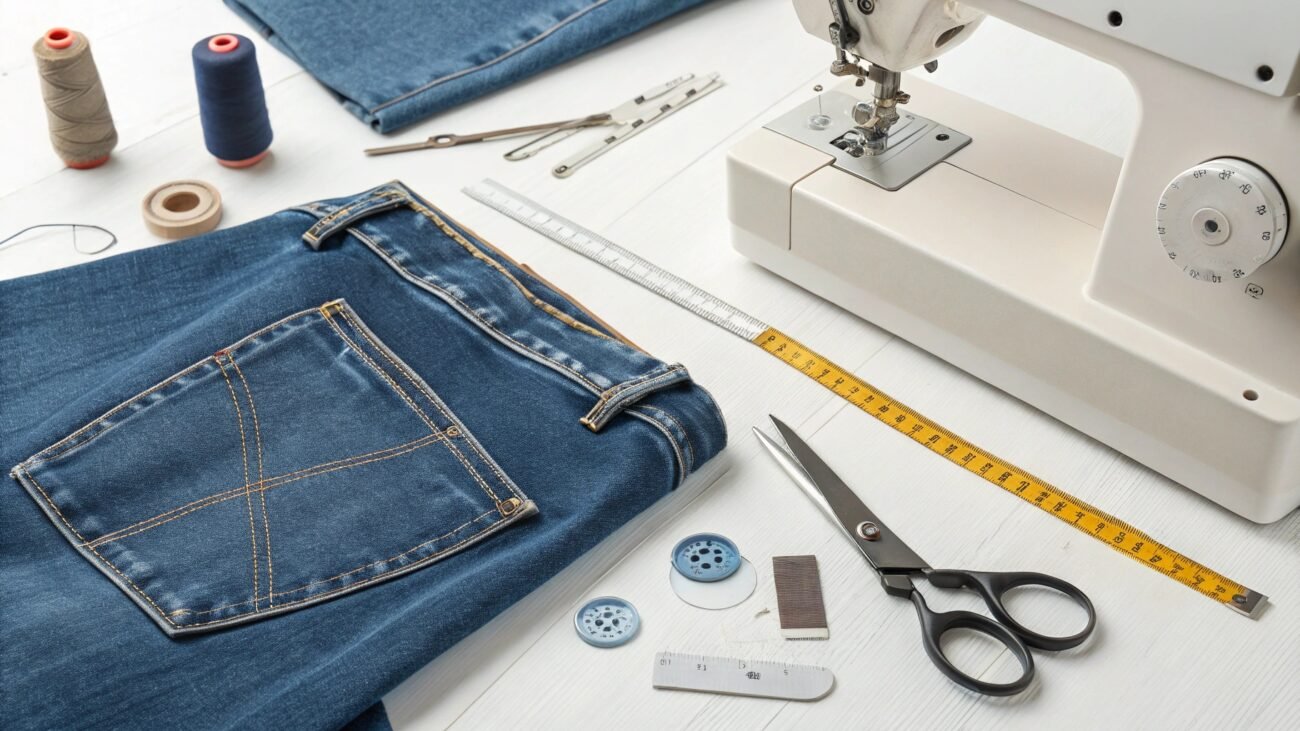
Crafting your own jeans is as easy as drawing because that’s basically what you will be doing.
- The journey to make custom denim clothing begins with Tech packs, which are basically like blueprints that include designs, measurements and structural layouts.
- Afterwards, it’s on your manufacturer’s shoulders to make your garments.
Tired of Finding High Quality Manufacturers for Your Low Moqs Order?
Introducing PLCM, we are the only manufacturer in the world who provides exceptionally low costing goods with market completing standards.
However, there are many overheads regarding clothing manufacturing you should be aware of; this is why I highly advise you to read the blog below.
Click Here: Unleash Your Vision: How to Start a Private Label Clothing Brand
FAQs Regarding Types of Denim
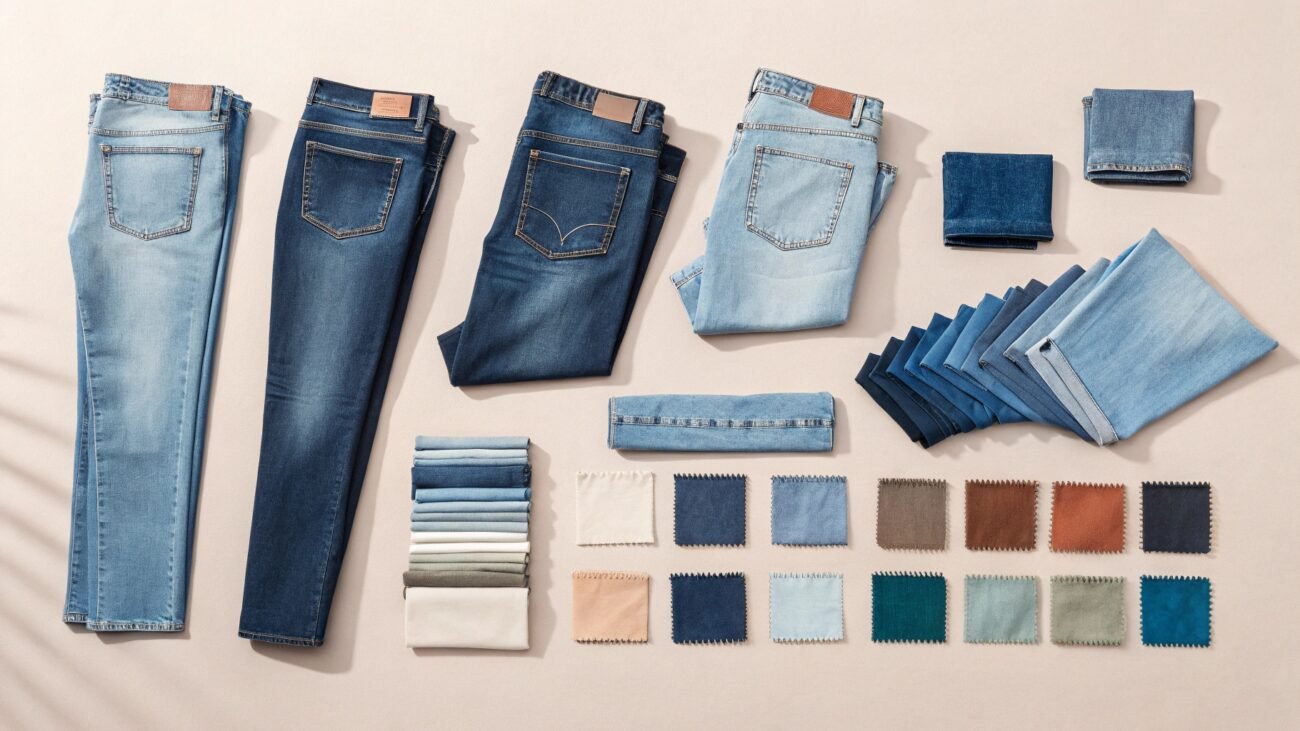
1) Are all denim cotton twill?
Yes, all denim types are made from cotton twill fabric; if your denim doesn’t have diagonal weaves, then without any doubts, your jeans are superficially induced to look like denim.
2) How to wash raw denim if it shrinks?
Washing raw denim can be tricky, as it can lead to shrinkage and eventually ill-fitting. However, you can instead opt for cold treatment. It is a type of cleaning method where you store your raw jeans in the refrigerator overnight to eliminate bacteria.
3) What are some different types of blue jeans?
Blue jeans come in a variety of fits, washes and styles. Some of the most popular choices are skinny jeans, straight-leg jeans and loose-fit jeans.


